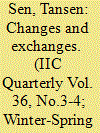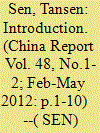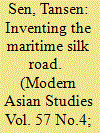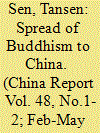|
|
|
Sort Order |
|
|
|
Items / Page
|
|
|
|
|
|
|
| Srl | Item |
| 1 |
ID:
054148


|
|
|
|
|
| Publication |
New Delhi, Manohar, 2004.
|
| Description |
xvi, 388p.
|
| Standard Number |
817304581X
|
|
|
|
|
|
|
|
|
|
|
|
Copies: C:1/I:0,R:0,Q:0
Circulation
| Accession# | Call# | Current Location | Status | Policy | Location |
| 048716 | 303.48251054/SEN 048716 | Main | On Shelf | General | |
|
|
|
|
| 2 |
ID:
128491


|
|
|
| 3 |
ID:
157648


|
|
|
|
|
| Publication |
New Delhi, Oxford University Press, 2018.
|
| Description |
xviii, 541p.pbk
|
| Standard Number |
9780199485543
|
|
|
|
|
|
|
|
|
|
|
|
Copies: C:1/I:0,R:0,Q:0
Circulation
| Accession# | Call# | Current Location | Status | Policy | Location |
| 059313 | 327.54051/SEN 059313 | Main | On Shelf | General | |
|
|
|
|
| 4 |
ID:
113706


|
|
|
| 5 |
ID:
190950


|
|
|
|
|
| Summary/Abstract |
Although inspired by the nineteenth-century term ‘Silk Road(s)’, the phrase ‘Maritime Silk Road’ has its own origins, connotations, and applications. This article examines the emergence of the latter term as a China-centric concept and its various entanglements since the early 1980s, involving the People’s Republic of China’s (PRC) political bodies, academia, the ‘open door’ policy, the pursuit of World Heritage listings, and the current ‘Belt and Road Initiative’. These entanglements, the article contends, have resulted in the emergence of what could be called a ‘Maritime Silk Road’ ecosystem in the PRC. The analysis of this ecosystem presented in the article reveals not only the processes through which a narrative on China’s engagement with the maritime world has been constructed over time, but also its association with issues of national pride, heritage- and tradition-making, foreign-policy objectives, and claims to territorial sovereignty. As such, the ‘Maritime Silk Road’ must be understood as a concept that is intimately entwined with the recent history of the PRC and distinct from its nineteenth-century antecedent, which was used as a label for overland connectivity.
|
|
|
|
|
|
|
|
|
|
|
|
|
|
|
|
| 6 |
ID:
113707


|
|
|
|
|
| Publication |
2012.
|
| Summary/Abstract |
Recent studies have significantly altered the ways in which the early history of Buddhism in China and the Buddhist interactions between ancient India and China were perceived. The accepted views about the route of the initial transmission of Buddhist doctrines, the early method of rendering Buddhist ideas into Chinese and the notion of a decline of Buddhism in China after the eighth century have all come under scrutiny. Using these analyses and arguments, this essay attempts to reassess some of the key issues concerning the spread and successful establishment of Buddhism in China. In particular, it re-examines the contribution of India-China interactions to these processes and argues that the diffusion of Buddhism in China was an outcome of multi-ethnic collaborations and the ingenuity of Chinese and foreign monks in making the doctrine adaptable to Chinese society.
|
|
|
|
|
|
|
|
|
|
|
|
|
|
|
|
|
|
|
|
|